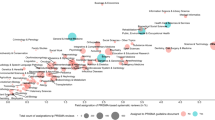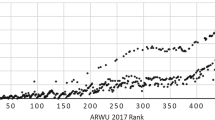Abstract
Background
Publication and citation rates mark the research activity and research quality of scientists.
Question
Are bibliometric indicators valid instruments for early recognition of high quality researchers?
Subjects and methods
The number of publications and citations of 26 assistant, associate and full professors of German psychiatry born after 1947 was analysed in their 30th and 31st year of age and between 1996 and 2000.
Results
58% of the selected 30 or 31 year old scientists had at least one publication in a journal with an impact factor, 93% of these as first or single author. 42% in this age group were at least cited once. Publication and citation rates in the early stage of a career provide hints on the later bibliometric data and the academic degree of scientists.
Conclusion
High quality researchers can be recognised early in their careers by means of worldwide accessible bibliometric indicators.
Similar content being viewed by others
References
B. Bauer, Habilitationskriterium Impact-Faktor, Medizin-bibliothek-information, 3 (2003) 40–43.
R. P. Kraft, Meßbarkeit von Forschungsqualität? Der Zeitschriften-Impact-Faktor und die Zitieranalyse, Krebsforschung heute, Berichte aus dem Deutschen Krebsforschungszentrum Darmstadt, (1998) 264–269.
S. Lehrl, Der Impact-Faktor als Bewertungskriterium wissenschaftlicher Leistungen — das Recht auf Chancengleichheit, Strahlentherapie und Onkologie, 175 (1999) 141–153.
J. Pantel, C. Mundt, Über die Evaluation von Forschungsleistungen in der Psychiatrie, Nervenarzt, 70 (1999) 281–287.
S. Lehrl, Die führenden Medizinforscher — Who’s Who der deutschen Medizin, Vless Verlag, Ebersberg, 1995.
H. H. Kornhuber, Mehr Forschungseffizienz durch objektivere Beurteilung von Forschungsleistungen. In: H. D. Daniel, R. Fisch, Evaluation von Forschung. Universitätsverlag, Konstanz, 1988, pp. 361–382.
C. Ell, E. Gunreben, S. Kettner, S. Lehrl, Forschungsaktivität und Forschungsqualität deutscher Gastroenterologen im Spiegel von Zitationsindizes, Zeitschrift für Gastroenterologie, 35 (1997) 23–28.
E. Garfield, Citation indexes for science: a new dimension in documentation through association of ideas, Science, 122 (1955) 108–111.
E. Garfield, Citation Indexing — Its Theory and Application in Science, Technology And Humanities, ISI Press, Philadelphia, 1979.
Institute for Scientific Information (seit den 60er Jahren regelmäßig): Science Citation Index SCI als Bände, später auf CD-ROM, Institute for Scientific Information, Philadelphia.
T. Opthof, Sense and nonsense about the impact factor, Cardiovascular Research, 33 (1997) 1–7.
R. Plomp, The highly cited papers of professors as an indicator of a research group’s scientific performance, Scientometrics, 29 (1994) 377–393.
J. R. Cole, S. Cole, Social Stratification in Science, University of Chicago Press, Chicago, 1973.
Wissenschaftsrat, Eckdaten und Kennzahlen zur Lage der Hochschulen von 1980 bis 2000, Geschäftsstelle, Köln, 2002.
H. A. Abt, The use of publication studies to affect policies and attitudes in astronomy, Part 1, Current Contents, 39 (1990) 7–11.
D. B. Herrmann, Zur Altersstruktur der Autoren bedeutender Forschungsergebnisse in der Astronomie des 20. Jahrhunderts (1900–1975), NTM, Schriftenreihe für Geschichte der Naturwissenschaften, Technik und Medizin, 24 (1987) 77–80.
H. Zuckerman, Scientific Elite: Nobel Laureates in the United States, Free Press, New York, 1977.
S. Lehrl, E. Grässel, Forschungsqualität deutscher Mediziner, Media Point Verlagsgesellschaft, Nürnberg, 1993.
Deutscher Hochschulverband, Hochschullehrer Verzeichnis Band 1: Universitäten Bundesrepublik Deutschland, Jackwerth & Welker Verlag, Bonn, 1994.
K. Hofmann, Kürschners Deutscher Gelehrten-Kalender, Band I–III, 18. auflage, K. G. Saur Verlag, München, 2001.
Deutscher Hochschulverband, Hochschullehrer Verzeichnis, Band 1: Universitäten Deutschland, 9. Ausgabe, K. G. Saur Verlag, München, 2001.
SPSS, Statistical Package for the Social Science 12.0 für Windows, SPSS Inc., Chicago (USA), 2003.
J. M. Collis, J. M. Barucky, “Big Five” Personality Factors Research using Christal’s Self Description Inventory, Internet (14.06.2006), http://www.ijo.org/imta96/paper03.html
S. D. Gosling, P. J. Rentfrow, W. B. Swann, A very brief measure of the big five personality domains, Journal of Research in Personality, 37 (2003) 504–528.
B. W. Roberts, A. Caspi, T. E. Moffitt, The kids are alright: growth and stability in personality development from adolescence to adulthood, Journal of Personality and Social Psychology, 81 (2001) 670–683.
S. Lehrl, Längsschnittuntersuchung zur Zitierhäufigkeit Gelehrter in der HNO-Heilkunde, HNO, 53 (2005) 415–422.
S. M. Lawani, Some bibliometric correlates of quality in scientific research, Scientometrics, 9 (1986) 13–25.
P. O. Seglen, Evaluation of scientific quality using citation analysis and other bibliometric methods, Nordisk Medicin, 104 (1989) 331–335.
P. O. Seglen, Why the impact factor of journals should not be used for evaluation research, British Medical Journal, 314 (1997) 498–502.
A. J. Nederhof, A. F. J. van Raan, Peer review and bibliometric indicators of scientific performance: a comparison of cum laude doctorates with ordinary doctorates in physics, Scientometrics, 11 (1987) 333–350.
E. Saling, A. Schino, SII — Science Impact Index, Geburtshilfe und Gynäkologie (alte Bundesländer) 1990, Universitätsverlag, Jena, 1992.
N. M. Meenen, Der Impact-Faktor — ein zuverlässiger scientometrischer Parameter? Unfallchirurgie, 23 (1997) 128–134.
R. M. May, The scientific wealth of nations, Science, 275 (1997) 793–796.
Author information
Authors and Affiliations
Corresponding author
Rights and permissions
About this article
Cite this article
Jacob, J.H., Lehrl, S. & Henkel, A.W. Early recognition of high quality researchers of the German psychiatry by worldwide accessible bibliometric indicators. Scientometrics 73, 117–130 (2007). https://doi.org/10.1007/s11192-006-1729-x
Received:
Published:
Issue Date:
DOI: https://doi.org/10.1007/s11192-006-1729-x




